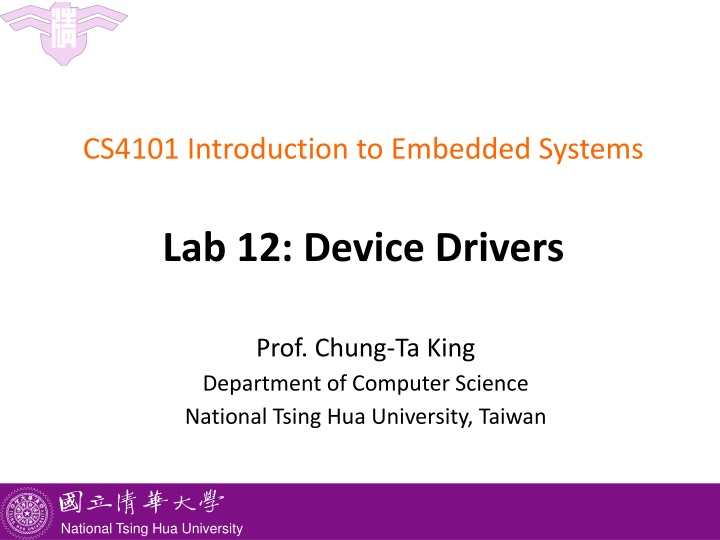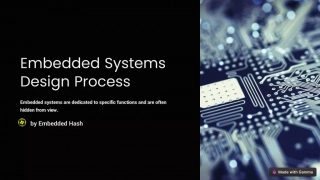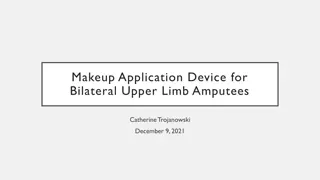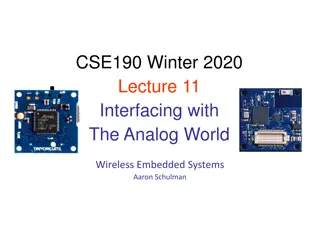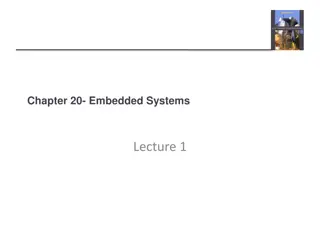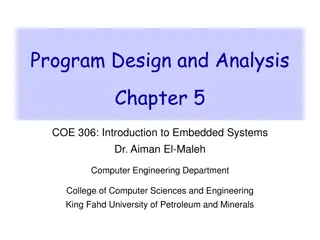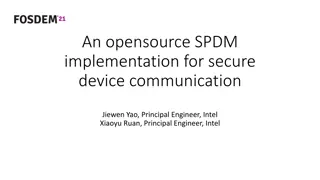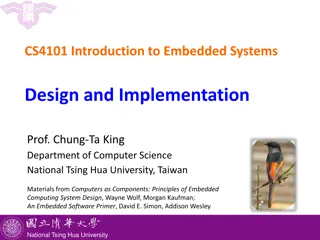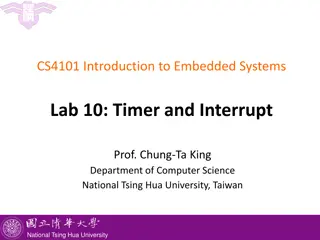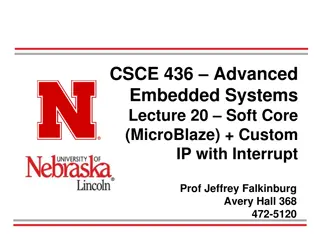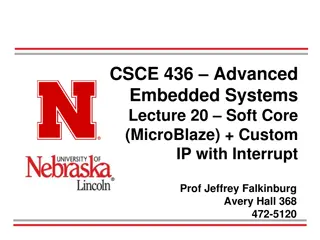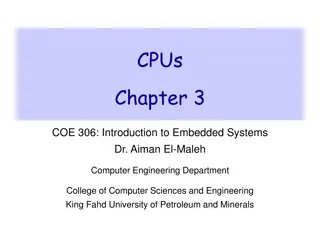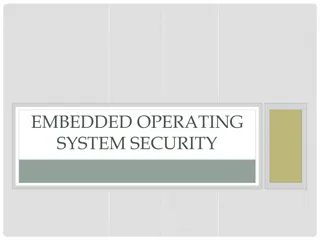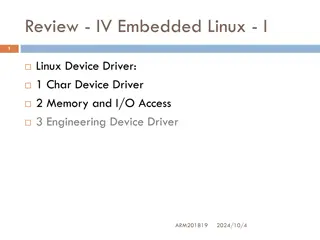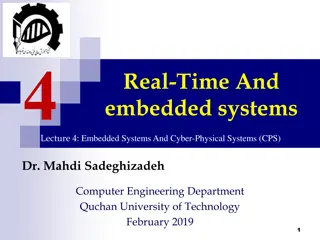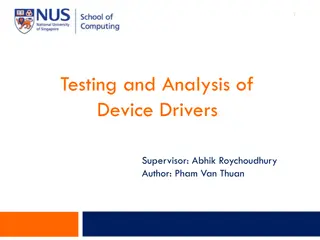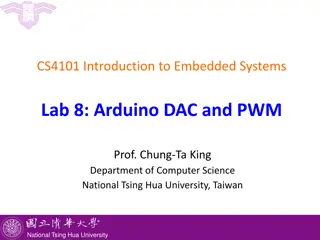Basics of Device Drivers for Embedded Systems
This lab introduces concepts related to device drivers in the context of embedded systems at National Tsing Hua University, Taiwan. It covers creating and installing null IO drivers, developing drivers for specific hardware like a 3-axis accelerometer, and the process of installing device drivers dynamically to interface with hardware components.
Download Presentation

Please find below an Image/Link to download the presentation.
The content on the website is provided AS IS for your information and personal use only. It may not be sold, licensed, or shared on other websites without obtaining consent from the author.If you encounter any issues during the download, it is possible that the publisher has removed the file from their server.
You are allowed to download the files provided on this website for personal or commercial use, subject to the condition that they are used lawfully. All files are the property of their respective owners.
The content on the website is provided AS IS for your information and personal use only. It may not be sold, licensed, or shared on other websites without obtaining consent from the author.
E N D
Presentation Transcript
CS4101 Introduction to Embedded Systems Lab 12: Device Drivers Prof. Chung-Ta King Department of Computer Science National Tsing Hua University, Taiwan National Tsing Hua University
Introduction In this lab, we will learn Basics of device drivers of MQX To create and install a null IO driver To develop a driver for the 3-axis accelerometer 1 National Tsing Hua University
Basics of I/O Device Drivers 2 National Tsing Hua University
I/O Device Drivers Dynamically installed software packages that provide a direct interface to hardware Driver installation: Each device driver has a driver-specific installation function, io_device_install(), which is called in init_bsp.c under mqx\source\bsp\ directory. The installation function then calls _io_dev_install() to register the device with MQX. To install a new device driver, the init_bsp.c needs to be modified and the BSP rebuilt 3 National Tsing Hua University
I/O Device Drivers Device names Device name must end with : , e.g. _io_mfs_install("mfs1:" ...) Characters following : are information passed to device driver by fopen() call, e.g., fopen("mfs1:bob.txt") opens file bob.txt on device mfs1: I/O device drivers must provide following services: _io_device_open: required _io_device_close: required _io_device_read: optional _io_device_write: optional _io_device_ioctl: optional 4 National Tsing Hua University
Null Driver The null device driver is an I/O device that functions as a device driver but does not perform any work. Code at mqx\source\io\io_null\ 5 National Tsing Hua University
Null Driver _mqx_uint _io_my_null_install(char_ptr identifier) /* idetifier identifies the device for fopen */ { _mqx_uint result; result = _io_dev_install(identifier, _io_my_null_open, _io_my_null_close, _io_my_null_read, _io_my_null_write, _io_my_null_ioctl, NULL); return result; } 6 National Tsing Hua University
Null Driver /* This function is called when the user calls fopen. It prepares the driver for subsequent read, write, and ioctl operations.*/ _mqx_int _io_my_null_open(MQX_FILE_PTR fd_ptr, char_ptr open_name_ptr, char_ptr flags) { /* Nothing to do */ return(MQX_OK); } 7 National Tsing Hua University
Null Driver _mqx_int _io_my_null_read(MQX_FILE_PTR fd_ptr, char_ptr data_ptr, _mqx_int num) { /* Body */ return(0); } /* Endbody */ _mqx_int _io_my_null_ioctl(MQX_FILE_PTR fd_ptr, _mqx_uint cmd, pointer param_ptr) { /* Body */ return IO_ERROR_INVALID_IOCTL_CMD; } /* Endbody */ ... 8 National Tsing Hua University
Using Null Driver #include <my_null_io.h> #define MY_TASK 5 extern void my_task(uint_32); TASK_TEMPLATE_STRUCT MQX_template_list[] = { {MY_TASK, my_task, 1500, 9, "null_test", MQX_AUTO_START_TASK, 0, 0}, {0} }; void my_task(uint_32 initial_data) { FILE_PTR null_file; uint_8 data[10]; if (IO_OK != _io_my_null_install("null:")) { printf("Error opening Null\n"); } 9 National Tsing Hua University
Using Null Driver if (NULL == (null_file = fopen("null:", NULL ))) { printf("Opening NULL device driver failed.\n"); _mqx_exit(-1); } if (write(null_file, data, 4 ) != 4) { printf("Writing to NULL driver failed.\n"); _mqx_exit(-1); } fclose(null_file); printf ("NULL driver working\n"); _mqx_exit(0); } 10 National Tsing Hua University
Installing a Null Device Driver The Freescale MQX software solution includes several I/O device drivers that can be used as a reference to develop your own. These drivers are located in your default installation folder (referred to in this document as <MQX_folder> ) inside the following path: <MQX_folder>\mqx\source\io 11 National Tsing Hua University
Under <mqx folder>/mqx/source/io, create a folder called my_null_io to contain your device driver. 12 National Tsing Hua University
Under the my_null_io folder, put the following 3 files: ionulprv.h, my_null_io.c, my_null_io.h 13 National Tsing Hua University
Drag-and-drop the whole my_null_io folder to your Codewarrior project inside the IO Drivers folder. bsp_twrk60d100m/Peripheral IO Drivers 14 National Tsing Hua University
When you finish the drag-and-drop action, you will see the following. 15 National Tsing Hua University
The projects will execute a .bat file, which, among other things, copies header files to the output directory. This file is located at: <mqx folder>\mqx\build\bat\bsp_twrk60d100m 16 National Tsing Hua University
Add the following line to the file copy "%ROOTDIR%\mqx\source\io\my_null_io\my_null_io.h" "%OUTPUTDIR%\my_null_io.h" /Y 17 National Tsing Hua University
Basic Lab I Test the Null Driver This device driver can be used by adding the following header to your application: #include <my_null_io.h> New a mqx project and add #include <my_null_io.h> to see if it can be built successfully or not. 18 National Tsing Hua University
Basic Lab II Create a driver for the 3-axis accelerometer by providing the five driver services. The read service should return the 6 bytes of data There is no need to provide the write service The control service can set to catch 8-bit or 14-bit data from the 3-axis accelerometer Create a new project to print the 3-axis value by calling the 3-axis accelerometer driver. 19 National Tsing Hua University
20 National Tsing Hua University
21 National Tsing Hua University
Write_I2C(I2C_ACCELEROMETER_ADDRESS,0x2A,0x03); On 0x03 mode, the MSB value of 3-axis is meaningful. So you need to catch the MSB data of 3-axis when reading the accelerometer. 22 National Tsing Hua University
3-axis Original Value The measured acceleration data are stored in the OUT_X_MSB, OUT_Y_MSB, OUT_Z_MSB registers as 2 s complement 8-bit numbers. Data bit 0 0 0 0 0 0 0 0 Sign bit Reference : http://en.wikipedia.org/wiki/Two%27s_complement 23 National Tsing Hua University
Bonus Use a button to toggle a flag that selects the return value from _io_null_read(). If the flag is equal to 0, then return the value of the 3 axis- accelerometer as in Basic Lab. If the flag is 1, then return additionally the inclination, e.g., right, left, front, back. To do this, you have to add a control function using _io_null_ioctl(), which is called when the button is pushed. X-axis Y-axis Z-axis Regular gravity value will be between 65 24 National Tsing Hua University
